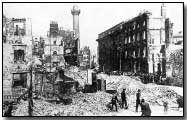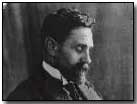Encyclopedia - Easter Rising
 Organised by Irish
nationalists as an armed rebellion against British rule in Ireland, the
Easter Rising of 1916, while not necessarily commanding wide scale public
support at its outset, nevertheless succeeded in generating a groundswell of
sympathy once the scale of British reprisals against the rebel leaders
became apparent.
Organised by Irish
nationalists as an armed rebellion against British rule in Ireland, the
Easter Rising of 1916, while not necessarily commanding wide scale public
support at its outset, nevertheless succeeded in generating a groundswell of
sympathy once the scale of British reprisals against the rebel leaders
became apparent.
The rebellion was launched from the steps of the venerable General Post Office building (G.P.O.) on Dublin's O'Connell Street a little after noon on Easter Monday, 24 April 1916. Patrick Pearse read from the steps of the G.P.O. a document (which he had himself prepared) proclaiming the fresh existence of an Irish Republic and the establishment of a Provisional Government.
To some extent the rebel leaders were relying upon the diversion of British attention to the ongoing war against the Central Powers. Nevertheless other nationalist sympathisers, including Sir Roger Casement, believed that the moment for open rebellion was not yet ripe; as such the latter set sail for Ireland from Germany with the intention of attempting to dissuade the rebel leadership from any immediate action.
In the event Casement was quickly arrested (and subsequently hanged) and the armed rebellion progressed. Moderate Irish nationalists had been disappointed with Britain's decision, in September 1914, to halt plans for Irish home rule for the duration of the war, thereby fanning the flames of armed protest as personified by such bodies as Sinn Fein, the Citizen Army and the Irish Volunteers.
 Thus
at midday on Easter Monday 1916 Pearse led some 2,000 supporters to the
G.P.O., commandeered it and read his proclamation. Other key Dublin
buildings were similarly occupied by the rebels.
Thus
at midday on Easter Monday 1916 Pearse led some 2,000 supporters to the
G.P.O., commandeered it and read his proclamation. Other key Dublin
buildings were similarly occupied by the rebels.
It took surprised British authorities the better part of a day to organise a response, which was inevitably armed. Martial law was declared (stretching across Ireland) and the rebels slowly driven back in violent street fighting until only the G.P.O. remained in rebel hands by 29 April. The arrival of British infantry and light artillery ended the siege with Pearse's surrender.
Until this point wider Irish public support for the rebels was at best muted. However the decision of the British (represented by newly-appointed Sir John Maxwell) to impose the death penalty (chiefly by firing squad) upon rebel leaders sparked increasing anger throughout the country, support which invaluably boosted the cause of post-war Irish nationalism.
Approximately 300 people died during the rebellion with a further 1,000 wounded or reported missing. Ironically the British government's reaction - led by Prime Minister Herbert Asquith - was excoriated by many for being overly lenient; the Prime Minister was also charged with taking a soft approach in order to appease valuable U.S. interests.
Those Irish leaders imprisoned rather than shot for their part in the rebelleion were subsequently released as part of an amnesty in 1917.
Click here to read Sir Roger Casement's speech in court following his conviction for treason; click here to read General Maxwell's report of the rising. Click here to read a more detailed summary of the rising by DublinTourist.com
"ANZAC" was coined in s1915 from the initials of the Australian and New Zealand Army Corps.
- Did you know?
